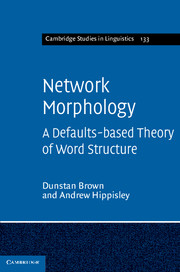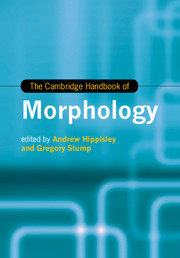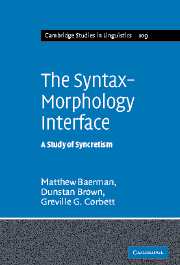Network Morphology
A Defaults-based Theory of Word Structure
$130.00 USD
Part of Cambridge Studies in Linguistics
- Authors:
- Dunstan Brown, University of York
- Andrew Hippisley, University of Kentucky
- Date Published: June 2012
- availability: This ISBN is for an eBook version which is distributed on our behalf by a third party.
- format: Adobe eBook Reader
- isbn: 9781139200400
Find out more about Cambridge eBooks
$
130.00 USD
Adobe eBook Reader
Other available formats:
Hardback
Looking for an inspection copy?
This title is not currently available on inspection
-
Morphology is particularly challenging, because it is pervaded by irregularity and idiosyncrasy. This book is a study of word structure using a specific theoretical framework known as 'Network Morphology'. It describes the systems of rules which determine the structure of words by construing irregularity as a matter of degree, using examples from a diverse range of languages and phenomena to illustrate. Many languages share common word building strategies and many diverge in interesting ways. These strategies can be understood by distinguishing different notions of 'default'. The Network Morphology philosophy promotes the use of computational implementation to check theories. The accompanying website provides the computer coded version of the Network Morphology model of word structure for readers to test, customize and develop. This book will be a valuable contribution to the fields of linguistic typology and morphology and will be welcomed by researchers and graduate students in these areas.
Read more- Proposes a robust theory of morphology, which accounts for both the structural properties of words and the relationship between morphology and syntax
- Through the accompanying website http://networkmorphology.as.uky.edu/ readers can download analyses and run them on a computer, for both theoretical and applied benefits
- Includes coverage of 'hot topics' in morphology, including syncretism and deponency
Reviews & endorsements
'… goes a long way towards clarifying many of the outstanding issues in linguistic morphology today.' Mark Aronoff, Trustees Distinguished Professor, Stony Brook University
See more reviews'… covers not only inflections and paradigm structure but also derivational relatedness … an invaluable survey.' Andrew Spencer, University of Essex
Customer reviews
Not yet reviewed
Be the first to review
Review was not posted due to profanity
×Product details
- Date Published: June 2012
- format: Adobe eBook Reader
- isbn: 9781139200400
- contains: 15 b/w illus. 3 tables
- availability: This ISBN is for an eBook version which is distributed on our behalf by a third party.
Table of Contents
1. Options in constructing a morphological framework
2. A framework for morphological defaults
3. Inflectional classes
4. Syncretism
5. Morphological mismatch and extended deponency
6. Defaults and paradigmatic restructuring
7. Derivation
8. Conclusion.
Sorry, this resource is locked
Please register or sign in to request access. If you are having problems accessing these resources please email [email protected]
Register Sign in» Proceed
You are now leaving the Cambridge University Press website. Your eBook purchase and download will be completed by our partner www.ebooks.com. Please see the permission section of the www.ebooks.com catalogue page for details of the print & copy limits on our eBooks.
Continue ×Are you sure you want to delete your account?
This cannot be undone.
Thank you for your feedback which will help us improve our service.
If you requested a response, we will make sure to get back to you shortly.
×






